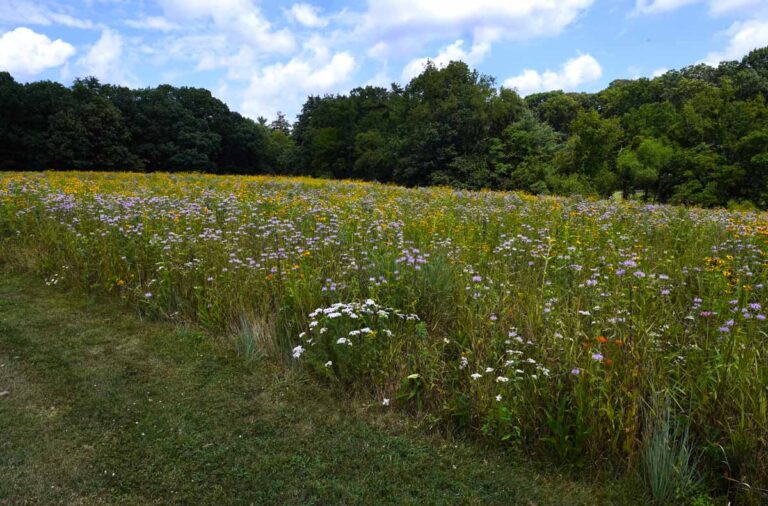When it comes to supporting pollinators, the challenge is consistency. Many gardens and restoration sites overlook critical windows, particularly early spring and late fall, when food scarcity can disrupt breeding, migration, or overwintering success.
Perennial pollinators are native plants that provide nectar and pollen year after year. These long-lived wildflowers offer reliable food sources for bees, butterflies, hummingbirds, and moths, helping to sustain pollinator populations throughout the growing season. Their importance to ecosystem health makes them a perfect choice for landscape architects, gardeners, and anyone interested in supporting their local pollinators while maximizing aesthetic appeal.
By selecting perennials with staggered bloom times, landowners can create a habitat that supports pollinators from the first thaw to the final frost.
In this blog, we’ll explore:
- Why native perennial plants outperform ornamentals for pollinator support
- The ecological importance of continuous seasonal bloom
- Plant-by-plant recommendations tailored to each season
- Habitat strategies that go beyond flowers alone
Let’s begin with why native perennials are the preferred choice for pollinator-focused planting projects.
Why Native Perennials Are Best for Pollinator Support
Perennial pollinators have particular benefits for critical pollinator species:
- Most importantly, native species have co-evolved with regional pollinators. As a result, native perennials produce nectar and pollen in forms that those insects can access and use efficiently.
- Some wild bees are pollen specialists, relying on a narrow range of plants like Goldenrod (Solidago) or Sunflowers (Helianthus) to reproduce.
- Hybrid ornamentals may look vibrant, but often lack the nectar or pollen volume needed to support insect populations.
- Perennials return each year, reducing replanting costs and labor.
- Deep root systems improve soil health, moisture retention, and plant resilience.
The benefits only increase over time too, since many perennials bloom more profusely after the first year and improve habitat as the years progress.
Backed by Research
According to a 2021 study by researchers from Penn State, planting flowers with extended bloom times can substantially boost wild bee populations on farms. In short, landowners who plant with pollinators in mind can make a measurable difference no matter the location.
When selected carefully, native perennial pollinators deliver ecological performance and lasting value for both the landscape and the species that depend on it.
Planning a Bloom Calendar for the Whole Season
Supporting pollinators isn’t just about what you plant, but also when those plants bloom. Seasonal gaps in nectar and pollen availability can leave bees, butterflies, and hummingbirds without the resources they need to survive and reproduce. That’s why building a pollinator-friendly garden or conservation area begins with mapping bloom periods across the growing season.
Seasonal Bloom Targets
To maintain consistent food sources from spring to fall, aim to include plants that peak during each of the following windows:
- Spring (March–May): Critical forage for emerging queen bumble bees and solitary bees recovering from winter hibernation.
- Summer (June–August): Peak activity for bees, butterflies, hummingbirds, and their offspring.
- Fall (August–October): Final nectar reserves for migrating species like monarchs and overwintering insects.
Key Design Considerations
- Layer blooms: Choose overlapping bloom periods so that multiple species are flowering at any given time.
- Plant in masses: Clusters of the same plant (minimum 3–5) increase visual recognition and foraging efficiency.
- Diversify form and structure: Incorporate a variety of flower shapes (tubular, daisy-like, clustered) and heights to attract a broader range of pollinators.
- Match species to site conditions: Sun-loving species like Purple Coneflower (Echinacea purpurea) and Wild Bergamot (Monarda fistulosa) perform best in open spaces, while part-shade options like Eastern Columbine (Aquilegia canadensis) thrive at woodland edges.
- Leave space for habitat: Bare soil patches support ground-nesting bees; dead stems and leaf litter provide winter shelter.
By planning with a bloom calendar in mind, owners of any kind of landscape can maximize habitat value across the entire growing season, not just during summer’s peak.
Top Early Bloomers for Spring Support
Early spring is a vulnerable time for pollinators in the Northeast. By late March or April, overwintering species like queen bumble bees and solitary mining bees begin to emerge. Without access to early-season nectar and pollen, these pollinators may struggle to survive, let alone establish new colonies.
To fill that gap, you’ll need to include spring-blooming perennials and shrubs that activate before the rest of the landscape catches up.
Here are several standout species that provide reliable forage during the spring ramp-up:
- Golden Alexanders (Zizia aurea): A reliable May bloomer that feeds mining bees, mason bees, and swallowtail caterpillars in moist, partly sunny sites.
- Columbine (Aquilegia canadensis): Produces red-and-yellow tubular blooms in late spring that attract hummingbirds, bumble bees, and hawk moths along woodland edges.
- Hairy Beardtongue (Penstemon hirsutus): Blooms in late spring with tubular white flowers favored by long-tongued bees and hummingbirds in full to partial sun.
- For best results, consider using a specialized seed mix prepared by the experts at Ernst.
By including these species in your planting plan, you create a strong foundation for pollinator activity in early spring. This is key to ensuring that pollinator species have the resources they need to recover from winter and establish new generations.
Perennial Pollinators for Summer
Summer is the high point of pollinator activity in the Northeast. Bees are foraging constantly to feed their colonies, butterflies are mating and laying eggs, and hummingbirds are fueling their high metabolism with every bloom they can find. This is also the easiest season to support so long as you plant species that offer abundant nectar, accessible pollen, and varied bloom structure.
Below are five native perennials that serve as summer standouts for pollinator support:
- Butterfly Milkweed (Asclepias tuberosa): Blooms from June through August, feeding bees, butterflies, and monarch caterpillars in dry, sunny conditions.
- Swamp Milkweed (Asclepias incarnata): Thrives in wetter soils, producing fragrant pink blooms that draw butterflies, bumble bees, and hummingbird moths.
- Purple Coneflower (Echinacea purpurea): Offers weeks of mid-to-late summer blooms for bees and butterflies, with seed heads that feed finches in fall.
- Wild Bergamot (Monarda fistulosa): Produces lavender shaggy blooms rich in nectar, attracting hummingbirds, long-tongued bees, and clearwing moths.
- Mountain Mint (Pycnanthemum muticum or P. tenuifolium): A mid-to-late summer generalist magnet that draws dozens of insect species, from bees and beetles to wasps and hoverflies.
Looking for more options? Consider one of our pollinator seed mixes.
Fall Bloomers That Finish Strong
Many flowers fade as the summer comes to a close, but pollinators still need fuel. Monarchs are migrating, native bees are building winter fat stores, and overwintering insects are making their final rounds. Without late-blooming plants, these species face a critical shortage of nectar and pollen when they need it most.
The following fall-blooming natives extend the foraging season and provide vital support when other resources disappear:
- Goldenrod (Solidago spp.): Blooms from late August into October, providing nectar and pollen for specialist pollinator species, bees, butterflies, and over 100 species of caterpillars (without causing allergies).
- Heath Aster (Aster pilosus): Offers numerous white, daisy-like flowers until late fall, drawing monarchs, bumble bees, and migrating butterflies.
- Great Blue Lobelia (Lobelia siphilitica): Its vibrant blue or purple flowers appear from mid-summer through early fall, attracting pollinators like bees and hummingbirds.
These fall-blooming species keep your habitat active into October, ensuring that pollinators have access to the resources they need to complete their life cycles and survive the approaching winter.
Winter Habitat Matters Too
Even after the final blooms fade, your pollinator garden can continue to serve an important ecological role, and all you have to do is leave it alone. Many native bees overwinter in hollow stems or underground burrows, while butterflies like the mourning cloak take shelter in leaf litter or brush. Cutting everything back in the fall may look tidy, but it removes critical winter habitat.
To protect overwintering pollinators:
- Leave standing stems of native perennials like coneflowers, monarda, and milkweed.
- Let fallen leaves accumulate in garden beds to insulate hibernating insects.
- Delay spring cleanup until temperatures consistently rise above 50°F, when pollinators begin to emerge.
These simple adjustments can dramatically improve winter survival rates for native pollinators and help ensure that the species your garden supports in summer have a chance to return next spring.
More Questions? Consult with Ernst to Design a Landscape with Perennial Pollinators in Mind
Creating a pollinator-friendly planting isn’t just about adding flowers, but building a season-long support system. By selecting for perennial pollinators and choosing plants that bloom in succession from early spring to late fall, and by preserving winter habitat, you can help sustain pollinators year-round. These efforts support not only bees and butterflies, but the broader ecological web that depends on them.
Whether you’re designing a native meadow, restoring a field margin, or adding biodiversity to a backyard garden, Ernst Conservation Seeds offers the species, seed mixes, and technical expertise to help you succeed.
If you have questions about species selection, site conditions, or custom blends for your project, contact the experts at Ernst for guidance tailored to your goals.

